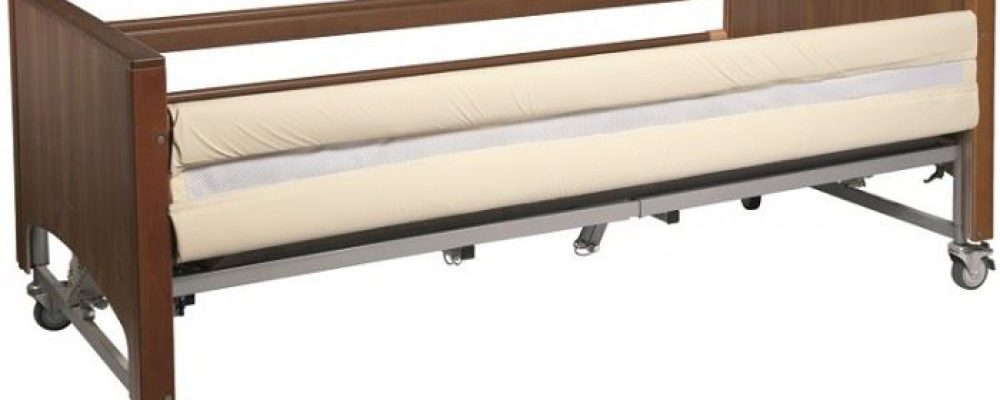Bed rails or cot sides are the specialist equipment used to prevent vulnerable people from falling out of bed. The use of bed rail is a common practice within care homes. Bed rails are considered as a ‘medical devise’. It falls under the authority of Medicines and Healthcare products Regulatory Agency (MHRA). MHRA monitors the design and safety aspects during its production. But CQC monitors the safe use of equipment under Regulation 12. As professionals, we want to make sure people are protected without affecting their freedom of movement. Fracture or asphyxia due to the unsafe use of bed rail is the last thing we want in our care homes.
CQC – on use of bed rails in care homes
CQC has the authority to prosecute if there are any breaches to the safety aspect in the use of bed rails under Regulation 12. CQC managed to successfully prosecute a provider for a serious accident with the wrong use of bed rails by ordering them to pay a fine of more than £150k and the provider was rated “Inadequate”.
CQC checks the following during their inspections:
- If an individual bed rail risk assessment is carried out for all the clients using bed rails.
- The process of ‘deciding to use bed rails’ by involving the residents.
- If the client lacks capacity, evidence of following MCA test and Best interest decision-making process.
- Applying for DOLS for the use of bed rails. Notifying CQC if DOLs is authorised.
- Evidence of checking the safety of the equipment on a regular basis.
- Evidence of training staff on
safe use of bed rails and assessingthier competency.
How using bed rails can go wrong?
The modern hospital beds come with manufacture fitted bed rails in line with MHRA guidance. The risk is higher when care homes buy bed rails from a third party to use it with divan beds or regular beds, which is still common in residential care homes than in nursing homes. Please ensure a thorough assessment and ongoing monitoring if you are doing this. Use of bed rails can go wrong in the following ways:
- The resident can become trapped between the bottom of the rail and the mattress if the gap beneath the rail is too large.
- Residents can become trapped between the end of the bed rail and the headboard or footboard if the rails are not secured in a safe position.
- Entrapment in the space between the side of the mattress and the rail.
- Entrapment can cause breathing problems and fractures.
- The risk of climbing over and falling.
- The resident is agitated and trying to damage the bed rails.
- The height of the mattress is in level with bed rails resulting in rolling out of bed.
- When it is used to restrict the freedom of movement for the resident.
Bed rails risk assessment
The following questions should be asked for the safe use of bed rails as per MHRA guidance.
- Is the bed rail to be used with a typically sized adult bed occupant?
- Has the bed rail been inspected and maintained regularly?
- Does the manufacturer/supplier provide any information on special considerations or contra-indications?
- Do you have enough information from the supplier to be able to select and fit the bed rail appropriately?
- Is the bed rail suitable for the intended bed, according to the supplier’s instructions?
- Do the fittings or mattress allow the bed rail to be fitted to the bed securely so that there is no excessive movement?
- Does the benefit of any special or extra mattress outweigh any increased entrapment risk by the bed rails created by extra compression at the mattress edge?
- Are the bed rails high enough to take into account any increased mattress thickness or additional overlay?
- Is the bed rail bumper of correct size and fit?
Have you made sure that there no gaps present that could present an entrapment risk to any part of patient’s body?
- between the bars of the bed rails? 120 mm max
- through any gap between the bed rail and side of the mattress? 120 mm max
- through the gap between the lower bed rail bar and the mattress, allowing for compression of the mattress at its edge? 120 mm max
- Is the headboard to the bed rail end gap less than 60 mm?
If you say “No” to any of the questions MHRA advises the risk of entrapment is ‘high’ and you will have to put measures in place to mitigate the risk.
Myths in using bed rails
During my mock inspections, I come across a variety of explanations on why bed rails are used or not used from the professionals. One of the usual comment is “We do not use bed rails for any of our residents” The attitude of using the bed rails as a last resort is excellent, but try not to get ‘over-fixated’ to the idea. Questions to consider?
- Can alternatives such as low profile beds, positional wedges or sensor alarm systems to be used?
- Can you use ‘crash mats’? Please do not use crash mats for people who are dying or who does not move in bed instead use bed rails.
- Can you not just use a thick mattress on the floor for the resident to sleep? Not everyone should sleep on a bed all the time.
Understanding the needs of the resident and finding the best solution with them is the correct intervention when using the bed rails. Bed rails can be highly useful for individuals who benefits from it, we shouldn’t put off the decision just because “we want to claim a zero bed rail policy’.
Bed rails guidance for care homes
CQC follows MHRA guidance on “Safe use of bed rails” for the inspection process. You must read it at least once and ensure compliance on an ongoing basis. How about delegating your safety champion to read this guidance and do an audit for your care home? Just auditing once will not guarantee safety within your care home, it is best to review the bed rails risk assessment monthly as a minimum. The staff will have to go to the resident’s room and check the bed rails properly before completing the paper work. Managers should also include bed rail checks on
Bed rails from the resident’s perspective
Imagine yourself as a resident of a care home. Getting admitted to a care home itself can be very upsetting and also thoughts about losing independence. The last thing you want to do is, putting up the side rails on the first day of admission as a surprise when they were used to lying down in a normal bed
- Can someone please explain to me why I should use a bed rail and the risks in using the bed rails?
- If I do not have the capacity, can the professionals speak to my family before restricting me with bed rails?
- What are the alternatives if I do not want to have bed rails?
- Can I still get out of bed if needed with assistance from the staff or will I be stuck in bed if the bed rails are up at the start of the night?
- What should I do if I need to use the toilet in the middle of staying in bed?
- Can staff make sure I have a ‘call bell’ and essentials within reach?
- What are the things that I shouldn’t do when having bed rails?
Sometimes as professionals, we ‘habitutalise’ things in a clinical way and forget the people behind it. Everyone deserves to have their voice heard despite physical or mental limitations. If not, we still have a duty to think from the perspective of the resident and make the right decision for them. I am sure you are already doing such an excellent job! Keep doing the excellent work.
Read my other blogs here.





